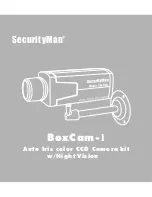
The combination of precision electronics, digital white light
filtering, and double shielding eliminates false alarms from the
sun and other visible light sources.
TX-2810-01-4 design has a neat and professional appearance
that gives no visible indication of the orientation of the detector
head and totally hides the wiring.
Quick installation
1. Mount and connect the detector following the instructions
given later in this sheet.
2. Fit two CR123 batteries provided into the top battery case.
Observe the polarity. See Figure 4.
The detection LED flashes three times.
3. Wait approximately 2 to 3 minutes to allow the detector to
settle.
4. Press the programming button once to activate walk test
mode.
The detection LED is now enabled for five minutes.
Note:
The front cover must be fitted when walk testing.
The default settings are:
•
Range: 30 meters / 98 feet
•
Pulse count: 1
Mounting the unit
During installation, protect the electronics against water, as
trapped moisture can affect or damage the unit.
We recommend that the screw mounting holes are sealed from
within the detector using acrylic (
non
-silicone based) sealants.
Note:
When locating the detector, please ensure the detector's
field of view is unobstructed.
To mount the detector:
1. Drill the wall to accept the two fixing screws, the cable
entry, and the tamper cup (if used). See Figures 1 and 3.
A hole-drilling template is provided.
Notes
•
Leave a minimum 10 cm (4 inches) clearance above
the top of the detector housing to allow the cover and
the detector to be positioned correctly.
•
We recommend using the tamper cup on uneven wall
surfaces.
•
The recommended optimum mounting height for the
detector is 3 m. Whilst it is possible to mount the unit
higher, this will give a reduced detection range and
will require the detection subject to move further
through the already reduced detection area before an
activation is signalled.
2. Remove the cover assembly by loosening the locking
screw. Squeeze the sides of the front cover to release the
internal catches. The cover hinges from the top and lifts
out of the location slot. See Figure 2.
3. Screw the unit to the wall ensuring that the tamper pin is
correctly located and that the tamper microswitch is
closed.
To aid installation, two spare tamper feet are provided.
One is 1 mm shorter and the other is 1 mm longer than the
tamper foot originally fitted. The tamper foot is a push fit
and can be removed by carefully pulling it from the pin.
See Figure 1.
4. When the detector is aligned, connected, and
programmed to suit the installation:
a. Fit the cover to the detector base.
b. Lightly screw the locking screw.
c. Put the top of the locking tool into the small notch on
each side of the cover, and then apply slight pressure
until the cover locks into the base, as shown in
Figure 17.
d. Tighten the locking screw.
Batteries
Only use CR123 3 V Lithium batteries (2X provided). This
ensures 3 years operation under normal conditions.
To extend battery life, a 3rd battery can be fitted into the rear of
the TX board. See Figure 5.
Observe correct polarity when fitting.
Battery safety information
•
Do not put in a fire
•
Do not heat
•
Do not charge
•
Do not short circuit
•
Do not disassemble
•
Only fit batteries of the same type and voltage
To preserve battery life the detector has a 2 minute sleep timer
after a detection. This is reduced to 5 seconds during walk test.
See also “Walk test” on page 7.
Multibeam alignment and masking
The multifunction lens fitted to the TX-2810-01-4 detector
produces seven long-range beams and seven medium- to
short-range curtain PIR beams. The PIR circuitry detects
changes in heat and movement in the beam pattern; therefore
items such as trees, shrubs, ponds, boiler flues, and animals
should be considered when positioning the detector.
Note:
PIR sensor is more sensitive to a movement across the
beams, and less sensitive to a movement directly towards or
away from the beams.
The detector module is fitted with two sliding shutters to reduce
the detection angle.
The curtains are fitted to the pan and tilt module as shown in
Figure 6. Each section of the detector lens gives a coverage
pattern of approximately 10 degrees.
An additional set of curtain sliders is provided should the beam
pattern be narrowed even further, e.g. if the minimum detection
angle of 10 degrees is required.
When coverage exceeds the desired detection area, adjust the
module as required and mask off any beams, either vertically
or horizontally, to avoid unwanted detection.
Use portions of the self-adhesive silver mask applied to the
rear, smooth side of the lens as shown in Figures
11
to 12.
P/N 1079515 (ML) • REV B • ISS 23JAN13
5 / 12






























